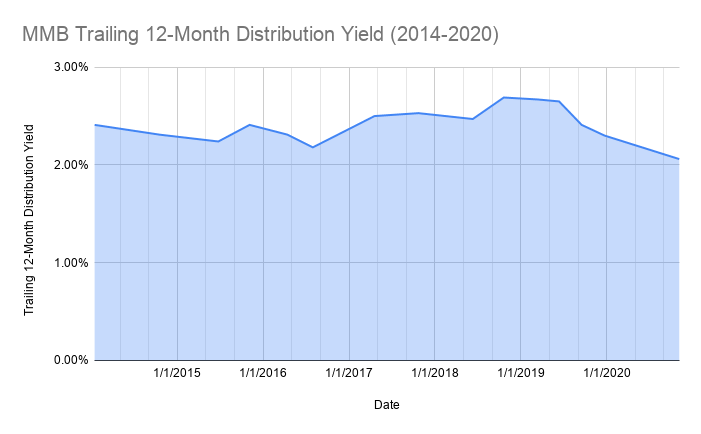
While my investment portfolio is designed for total return, I also track the income produced. Stock dividends are the portion of profits that businesses have decided they don’t need to reinvest into their business. The dividends may suffer some short-term drops, but over the long run they have grown faster than inflation. Interest from bonds and bank deposits are steadier, but these days it’s a struggle to simply keep up with inflation.
I track the “TTM” or “12-Month Yield” from Morningstar, which is the sum of the trailing 12 months of interest and dividend payments divided by the last month’s ending share price (NAV) plus any capital gains distributed over the same period. I prefer this measure because it is based on historical distributions and not a forecast. Below is a close approximation of my portfolio (2/3rd stocks and 1/3rd bonds).
| Asset Class / Fund | % of Portfolio | Trailing 12-Month Yield (Taken 12/24/19) | Yield Contribution |
| US Total Stock Vanguard Total Stock Market Fund (VTI, VTSAX) |
25% | 1.72% | 0.43% |
| US Small Value Vanguard Small-Cap Value ETF (VBR) |
5% | 2.22% | 0.11% |
| International Total Stock Vanguard Total International Stock Market Fund (VXUS, VTIAX) |
25% | 2.60% | 0.65% |
| Emerging Markets Vanguard Emerging Markets ETF (VWO) |
5% | 2.76% | 0.14% |
| US Real Estate Vanguard REIT Index Fund (VNQ, VGSLX) |
6% | 3.86% | 0.23% |
| Intermediate-Term High Quality Bonds Vanguard Intermediate-Term Treasury ETF (VGIT) |
17% | 1.72% | 0.29% |
| Inflation-Linked Treasury Bonds Vanguard Short-Term Inflation-Protected Securities ETF (VTIP) |
17% | 1.25% | 0.21% |
| Totals | 100% | 2.06% |
Trailing 12-month yield history. Here is a chart showing how this 12-month trailing income rate has varied since I started tracking it in 2014.

Reality check. One of the things I like about using this number is that when stock prices drop, this percentage metric usually goes up – which makes me feel better in a bear market. When stock prices go up, this percentage metric usually goes down, which keeps me from getting too euphoric during a bull market. I see it as a conservative, valuation-based indicator of how much I can withdraw perpetually, due to our very long retirement horizon of 40+ years. During 2020, the lower income rate suggests that while the value of my portfolio is up, the future returns also look lower due to high valuations and low interest rates.
Despite reading countless articles debating this topic, I still feel a 3% withdrawal rate remains a reasonable target for planning purposes if you want to retire young (before age 50) and a 4% withdrawal rate is a reasonable target if retiring at a more traditional age (closer to 65). If you are not close to retirement, your time is better spent focusing on earning potential via better career moves, investing in your skillset, and/or looking for entrepreneurial opportunities where you own equity in a business.
For the past few years, our portfolio has distributed about 2% to 2.5% in the form of dividends and interest. If we were to stop working, we would then take out another 0.5% to 1% by selling a few shares and then we’d have our 3%. Right now, we are both still generating some employment income (though significantly less in 2020) and withdraw less than this income number, so we don’t have to sell anything.
Practical and personal implications. I let all of our dividends and interest accumulate without automatic reinvestment. I treat this money as our “paycheck”. Then, as with a real paycheck, we can choose to either spend it or reinvest in more stocks and bonds.
Instead of trying to purely live off the income, we use it to enable us to have more flexible working hours as parents of three young kids. On a good day, we look forward to a day of work with adults (who can wipe their own butts) and then we look forward to the next day of spending all day with the kids (who can experience pure joy and wonder). If we’re being honest, I don’t think either of us truly wants to be a full-time stay-at-home parent while the other works for money full-time. Nor do we want to be the full-time worker while the other stays at home. There would likely be resentment issues both ways.
But the portfolio income is what makes it all possible. We are very thankful for this financial flexibility, which has been both a result of conscious preparation over 15+ years and good fortune. Others may use their portfolio income to pursue their passions, start a new business, travel around the world, sit on a beach, do charity or volunteer work, and so on. I may not be “retired”, but I am still glad we seriously pursued financial freedom before having kids.
 The Best Credit Card Bonus Offers – 2025
The Best Credit Card Bonus Offers – 2025 Big List of Free Stocks from Brokerage Apps
Big List of Free Stocks from Brokerage Apps Best Interest Rates on Cash - 2025
Best Interest Rates on Cash - 2025 Free Credit Scores x 3 + Free Credit Monitoring
Free Credit Scores x 3 + Free Credit Monitoring Best No Fee 0% APR Balance Transfer Offers
Best No Fee 0% APR Balance Transfer Offers Little-Known Cellular Data Plans That Can Save Big Money
Little-Known Cellular Data Plans That Can Save Big Money How To Haggle Your Cable or Direct TV Bill
How To Haggle Your Cable or Direct TV Bill Big List of Free Consumer Data Reports (Credit, Rent, Work)
Big List of Free Consumer Data Reports (Credit, Rent, Work)
What about emergency funds? Where do you park it? VMMXX ??
Long time reader –
I park my emergency funds in FDIC-insured banks with the highest rates. I update my list of top interest rates each month:
https://www.mymoneyblog.com/category/banking